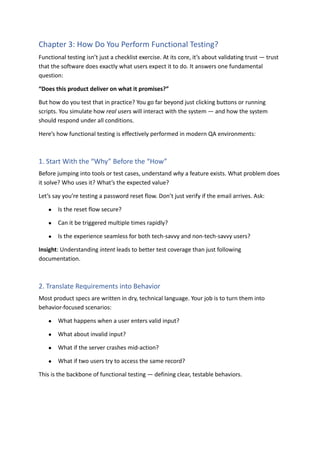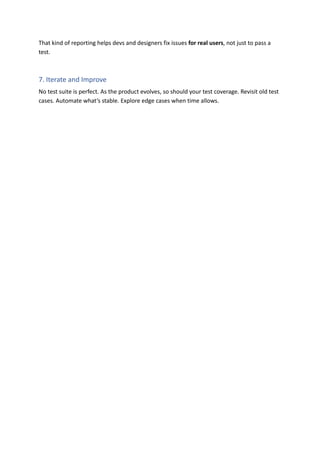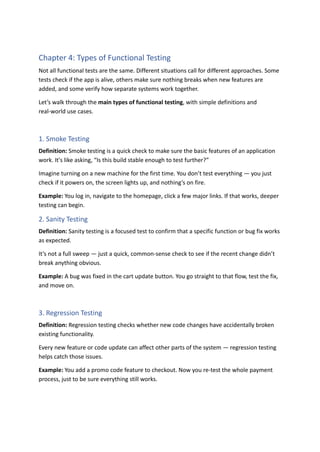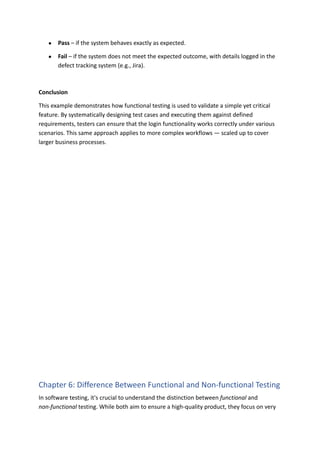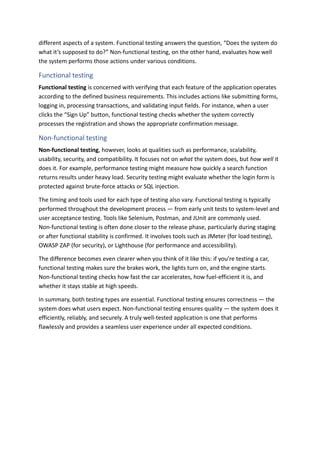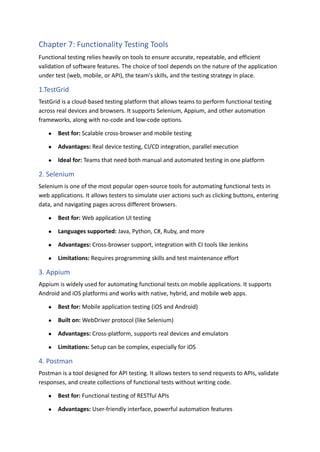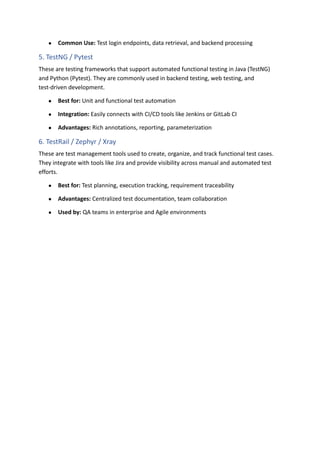Types of Functional Testing Every QA Must Know
- 2. Table of Contents 1.What is Functional Testing? 2.What Do You Test in Functionality Testing? 3.How Do You Perform Functional Testing? 4.Types of Functional Testing 5.Functional Testing Example 6.Difference Between Functional and Non-functional Testing 7.Functionality Testing Tools
- 3. Chapter 1: What is Functional Testing? Functional Testing is a type of software testing that validates the software system against the functional requirements or specifications. The purpose of functional testing is to ensure that the software behaves as expected and delivers the intended output when provided with specific inputs. This form of testing primarily focuses on: ● What the system does rather than how it does it. ● User interface, APIs, databases, security, and client/server applications. ● Ensuring each function of the application operates in conformance with the requirement specification. Key Characteristics: ● Black-box testing technique: Testers do not concern themselves with internal code structure. ● Primarily business logic-based: It validates how well the system meets the intended use. ● Can be done manually or using automation tools. ● Usually performed during the system testing phase, but can also be part of acceptance testing. Functional Testing Focuses On: ● Correct data input and expected output ● User interface behavior ● Data processing and business logic rules ● Security features (e.g., login, permission controls) ● Links and navigations within the application Objective: To confirm that the application works in accordance with the defined functional requirements and delivers accurate and reliable results.
- 4. Chapter 2: What do you Test in Functionality Testing? In functional testing, the goal is to verify that every feature of the software product operates in conformance with the business requirements. The scope of testing includes both visible user interactions and behind-the-scenes processing. Key Areas You Test in Functional Testing: 1. User Interface (UI) Elements ● Are buttons, input fields, drop-downs, checkboxes, and links working correctly? ● Do they perform the right actions on user interaction? ● Is the UI responsive and aligned with the design specifications? 2. Input Validation ● How does the system respond to valid and invalid inputs? ● Are error messages clear and correct when bad input is provided? ● Does the application accept data within expected formats and ranges? 3. Business Logic Validation ● Are rules for transactions, calculations, workflows, and decisions implemented properly? ● For example, applying a discount code during checkout or calculating taxes based on location. 4. Database Interaction ● Are data correctly saved, updated, deleted, or fetched from the database? ● Are constraints (like unique IDs or foreign keys) respected? 5. APIs and Backend Services ● Do APIs return correct data and status codes? ● Are third-party integrations working as expected (e.g., payment gateways, SMS/email services)? 6. Authentication and Authorization ● Is login functionality working? ● Are role-based access restrictions properly enforced? ● Are sessions managed securely?
- 5. 7. Navigation and Links ● Do menus and buttons lead to the right pages or sections? ● Are all internal and external links working? 8. Error Handling and Alerts ● Does the system show appropriate messages on errors (404, 500, validation failures)? ● Are critical failures gracefully managed without crashing the app? Why is This Important? Testing all of these aspects ensures the product: ● Matches the requirements ● Provides a smooth user experience ● Handles edge cases and errors gracefully ● Is reliable for end users in real-world usage
- 6. Chapter 3: How Do You Perform Functional Testing? Functional testing isn’t just a checklist exercise. At its core, it’s about validating trust — trust that the software does exactly what users expect it to do. It answers one fundamental question: “Does this product deliver on what it promises?” But how do you test that in practice? You go far beyond just clicking buttons or running scripts. You simulate how real users will interact with the system — and how the system should respond under all conditions. Here’s how functional testing is effectively performed in modern QA environments: 1. Start With the “Why” Before the “How” Before jumping into tools or test cases, understand why a feature exists. What problem does it solve? Who uses it? What’s the expected value? Let’s say you’re testing a password reset flow. Don’t just verify if the email arrives. Ask: ● Is the reset flow secure? ● Can it be triggered multiple times rapidly? ● Is the experience seamless for both tech-savvy and non-tech-savvy users? Insight: Understanding intent leads to better test coverage than just following documentation. 2. Translate Requirements into Behavior Most product specs are written in dry, technical language. Your job is to turn them into behavior-focused scenarios: ● What happens when a user enters valid input? ● What about invalid input? ● What if the server crashes mid-action? ● What if two users try to access the same record? This is the backbone of functional testing — defining clear, testable behaviors.
- 7. 3. Design Meaningful Test Cases Each test case is a story: ● Actor: Who is performing the action? ● Action: What are they doing? ● Reaction: What should the system do? Functional test cases should simulate real-world use. Not just “click submit” — but “User submits payment info during a flash sale on mobile data.” Use both positive tests (it works) and negative tests (what if it doesn’t?). 4. Use the Right Tools (But Know When Not To) Yes, tools matter — Selenium, Playwright, Postman, TestGrid, Cypress — but they don’t guarantee quality. Tools are amplifiers, not substitutes for thinking. When testing: ● APIs? Use Postman or REST Assured. ● Web interfaces? Use Selenium or Cypress. ● Mobile apps? Use Appium or cloud-based device testing platforms. But always test manually first when exploring unfamiliar flows. Tools automate what’s understood — not what’s uncertain. 5. Collaborate Closely With Devs & Product Owners Functional testers are the last line of defense before release. Sit with developers. Ask product managers why something was designed a certain way. Great functional testing often uncovers missed requirements, confusing logic, or dead-end user flows — because testers look at it with fresh, unbiased eyes. 6. Document Failures as User Stories Don’t just log “error on clicking X.” Instead: “When the user clicks ‘Pay Now’ after entering a valid card, the page freezes for 8 seconds with no feedback. A typical user might assume the app is broken.”
- 8. That kind of reporting helps devs and designers fix issues for real users, not just to pass a test. 7. Iterate and Improve No test suite is perfect. As the product evolves, so should your test coverage. Revisit old test cases. Automate what’s stable. Explore edge cases when time allows.
- 9. Chapter 4: Types of Functional Testing Not all functional tests are the same. Different situations call for different approaches. Some tests check if the app is alive, others make sure nothing breaks when new features are added, and some verify how separate systems work together. Let’s walk through the main types of functional testing, with simple definitions and real-world use cases. 1. Smoke Testing Definition: Smoke testing is a quick check to make sure the basic features of an application work. It's like asking, “Is this build stable enough to test further?” Imagine turning on a new machine for the first time. You don’t test everything — you just check if it powers on, the screen lights up, and nothing’s on fire. Example: You log in, navigate to the homepage, click a few major links. If that works, deeper testing can begin. 2. Sanity Testing Definition: Sanity testing is a focused test to confirm that a specific function or bug fix works as expected. It’s not a full sweep — just a quick, common-sense check to see if the recent change didn’t break anything obvious. Example: A bug was fixed in the cart update button. You go straight to that flow, test the fix, and move on. 3. Regression Testing Definition: Regression testing checks whether new code changes have accidentally broken existing functionality. Every new feature or code update can affect other parts of the system — regression testing helps catch those issues. Example: You add a promo code feature to checkout. Now you re-test the whole payment process, just to be sure everything still works.
- 10. 4. Integration Testing Definition: Integration testing checks how different modules or systems work together. Most modern apps aren’t just one block — they’re multiple components (APIs, databases, third-party services) working in sync. Integration testing makes sure those connections behave properly. Example: A user places an order → inventory updates → an email is triggered. Integration testing ensures all of that happens smoothly. 5. System Testing Definition: System testing validates the entire software application — end to end — against the functional requirements. It’s the full package. All modules, features, and interactions are tested in a complete environment, just like a user would use them. Example: From signing up → searching a product → adding to cart → payment → receiving confirmation. Everything is tested together. 6. User Acceptance Testing (UAT) Definition: UAT is the final phase of testing where the actual users or stakeholders verify whether the software meets business needs. It’s not about bugs — it’s about whether the system does what they asked for and solves their problem. Example: A retail company checks if their custom POS software handles pricing, sales, and customer reports exactly how their team works day-to-day. 7. Exploratory Testing Definition: Exploratory testing is unscripted testing where the tester actively explores the system to find hidden bugs or edge cases. There’s no predefined test case — it’s about thinking like a curious user and trying things the spec didn’t cover. Example: You open five tabs with the same product, try to change the quantity in each, refresh mid-checkout, and see how the app reacts.
- 11. A Simple Way to Remember It: Testing Type Purpose Best Time to Use Smoke Testing Quick basic checks After new build Sanity Testing Quick fix validation After minor changes Regression Testing Check old features still work After updates or new features Integration Testing Ensure components talk to each other When multiple systems are involved System Testing Full app behavior Before UAT or release
- 12. Chapter 5: Functional Testing Example To fully understand how functional testing is applied in a real-world scenario, this chapter provides a practical example involving a common web application feature — the user login functionality. This example outlines the steps for planning, designing, and executing functional tests based on specified requirements. Functional Requirement The application must allow registered users to log in using a valid email address and password. If the credentials are incorrect, an appropriate error message must be displayed. The login process must redirect the user to the dashboard upon success. Test Scenario: User Login This test scenario focuses on verifying the behavior of the login feature under both valid and invalid input conditions. Test Cases Test Case ID Description Input Expected Result TC001 Valid login credentials Registered email and correct password User is redirected to the dashboard TC002 Invalid password Registered email and incorrect password Error message: “Incorrect password” TC003 Unregistered email Unregistered email and any password Error message: “User not found” TC004 Blank email and password Empty fields Error message: “Email and password are required” TC005 Password field masked Any password Password characters are hidden TC006 Login button disabled with empty fields No input Login button remains disabled
- 13. Test Case ID Description Input Expected Result TC007 Redirect to dashboard on successful login Valid credentials User is redirected to dashboard page Test Execution Environment Setup: ● Web browser: Chrome (latest version) ● Backend: Staging server ● Database: Test database with seeded user credentials Steps to Execute TC001: 1. Navigate to the login page. 2. Enter a valid email address (e.g., [email protected]). 3. Enter the correct password. 4. Click the “Login” button. Expected Outcome: ● System authenticates the user. ● User is redirected to the dashboard page. ● Session is created and user remains logged in. Validation Points ● All error messages must be visible and clear. ● The login button should be disabled until all required fields are filled. ● The password field should use masked input for security. ● Page redirection should occur only after successful authentication. ● Sessions should be managed correctly to prevent unauthorized access. Result Documentation Each test case result should be recorded as:
- 14. ● Pass – if the system behaves exactly as expected. ● Fail – if the system does not meet the expected outcome, with details logged in the defect tracking system (e.g., Jira). Conclusion This example demonstrates how functional testing is used to validate a simple yet critical feature. By systematically designing test cases and executing them against defined requirements, testers can ensure that the login functionality works correctly under various scenarios. This same approach applies to more complex workflows — scaled up to cover larger business processes. Chapter 6: Difference Between Functional and Non-functional Testing In software testing, it's crucial to understand the distinction between functional and non-functional testing. While both aim to ensure a high-quality product, they focus on very
- 15. different aspects of a system. Functional testing answers the question, “Does the system do what it’s supposed to do?” Non-functional testing, on the other hand, evaluates how well the system performs those actions under various conditions. Functional testing Functional testing is concerned with verifying that each feature of the application operates according to the defined business requirements. This includes actions like submitting forms, logging in, processing transactions, and validating input fields. For instance, when a user clicks the “Sign Up” button, functional testing checks whether the system correctly processes the registration and shows the appropriate confirmation message. Non-functional testing Non-functional testing, however, looks at qualities such as performance, scalability, usability, security, and compatibility. It focuses not on what the system does, but how well it does it. For example, performance testing might measure how quickly a search function returns results under heavy load. Security testing might evaluate whether the login form is protected against brute-force attacks or SQL injection. The timing and tools used for each type of testing also vary. Functional testing is typically performed throughout the development process — from early unit tests to system-level and user acceptance testing. Tools like Selenium, Postman, and JUnit are commonly used. Non-functional testing is often done closer to the release phase, particularly during staging or after functional stability is confirmed. It involves tools such as JMeter (for load testing), OWASP ZAP (for security), or Lighthouse (for performance and accessibility). The difference becomes even clearer when you think of it like this: if you're testing a car, functional testing makes sure the brakes work, the lights turn on, and the engine starts. Non-functional testing checks how fast the car accelerates, how fuel-efficient it is, and whether it stays stable at high speeds. In summary, both testing types are essential. Functional testing ensures correctness — the system does what users expect. Non-functional testing ensures quality — the system does it efficiently, reliably, and securely. A truly well-tested application is one that performs flawlessly and provides a seamless user experience under all expected conditions.
- 16. Chapter 7: Functionality Testing Tools Functional testing relies heavily on tools to ensure accurate, repeatable, and efficient validation of software features. The choice of tool depends on the nature of the application under test (web, mobile, or API), the team's skills, and the testing strategy in place. 1.TestGrid TestGrid is a cloud-based testing platform that allows teams to perform functional testing across real devices and browsers. It supports Selenium, Appium, and other automation frameworks, along with no-code and low-code options. ● Best for: Scalable cross-browser and mobile testing ● Advantages: Real device testing, CI/CD integration, parallel execution ● Ideal for: Teams that need both manual and automated testing in one platform 2. Selenium Selenium is one of the most popular open-source tools for automating functional tests in web applications. It allows testers to simulate user actions such as clicking buttons, entering data, and navigating pages across different browsers. ● Best for: Web application UI testing ● Languages supported: Java, Python, C#, Ruby, and more ● Advantages: Cross-browser support, integration with CI tools like Jenkins ● Limitations: Requires programming skills and test maintenance effort 3. Appium Appium is widely used for automating functional tests on mobile applications. It supports Android and iOS platforms and works with native, hybrid, and mobile web apps. ● Best for: Mobile application testing (iOS and Android) ● Built on: WebDriver protocol (like Selenium) ● Advantages: Cross-platform, supports real devices and emulators ● Limitations: Setup can be complex, especially for iOS 4. Postman Postman is a tool designed for API testing. It allows testers to send requests to APIs, validate responses, and create collections of functional tests without writing code. ● Best for: Functional testing of RESTful APIs ● Advantages: User-friendly interface, powerful automation features
- 17. ● Common Use: Test login endpoints, data retrieval, and backend processing 5. TestNG / Pytest These are testing frameworks that support automated functional testing in Java (TestNG) and Python (Pytest). They are commonly used in backend testing, web testing, and test-driven development. ● Best for: Unit and functional test automation ● Integration: Easily connects with CI/CD tools like Jenkins or GitLab CI ● Advantages: Rich annotations, reporting, parameterization 6. TestRail / Zephyr / Xray These are test management tools used to create, organize, and track functional test cases. They integrate with tools like Jira and provide visibility across manual and automated test efforts. ● Best for: Test planning, execution tracking, requirement traceability ● Advantages: Centralized test documentation, team collaboration ● Used by: QA teams in enterprise and Agile environments





